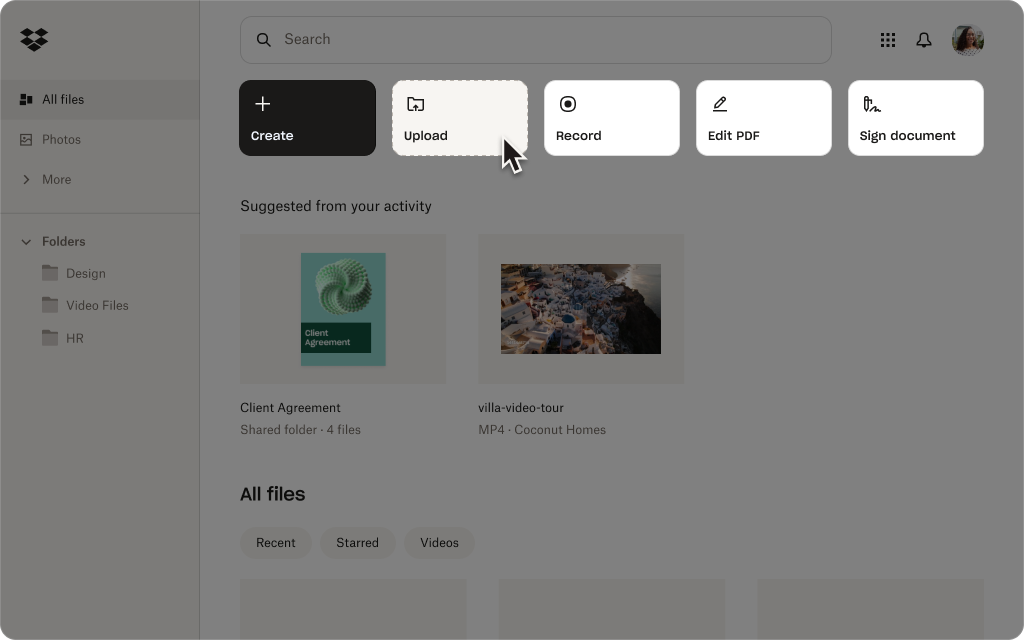Taking notes while screen sharing, leading a meeting, or when people are talking can be challenging. Summarizing action items from the meeting can also be difficult. This guide will show you how to write better meeting minutes and capture key information.
Dropbox makes it much easier to take effective meeting notes by providing a free meeting minutes template and giving you the following:
- Automatic saving and backup features to sync meeting notes in real time, so you can focus on the meeting
- Shared documents, so team members can view and contribute to the meeting agenda before or during the meeting—no need to multitask
- Features to help transcribe recordings automatically, making it simpler to see what was discussed and make follow-ups or set the next meeting’s agenda items
- Real-time updates for documents, which people can view anytime, anywhere—so everyone’s on the same page

Meeting notes template
Getting the free meeting notes template in Dropbox Paper is the first step for the in-depth tips and techniques we’ll cover in this guide.
It’s part of a broad range of templates available—so check out the full Dropbox Paper template library for to-do lists, project planning templates, and much more.
Why create meeting notes in the first place?
How often do you really look back at your meeting notes? If meeting notes feel like a chore and you never look at them again, you might be asking yourself why you’re creating them in the first place.
The reality is, if nobody—including yourself—is using your meeting notes, it's probably a sign that they’re not useful in their current format.
So, what’s the real goal of meeting notes? What should they actually be doing?
Well, at their core, meeting notes should be a tool to help everyone stay on the same page—literally. Your meeting notes should provide everyone with:
- A clear and concise summary of what was discussed
- Highlights of the key takeaways from those discussions
- An outline of the agreed action items and next steps
Ultimately, meeting notes are your roadmap for what needs to happen after the meeting ends and people get back to work.
Think of your notes as a single source of truth. Later, when someone wonders what was agreed upon or what their next task is, they can easily refer to the previous meeting minutes.
Also, if someone missed the meeting, your notes should be comprehensive enough to bring absentees up to speed—without needing a full recap of discussion points.
Create your meeting notes correctly with the right template and you’ll save time, boost productivity, and keep everyone on track.
Helpful meeting notes: An example scenario
Let’s look at how streamlined meeting notes work in a real-world scenario.
Imagine running a meeting about launching a promotion on the company’s website. A lot of topics are going to come up in this discussion, but the great notes focus on what really matters—capturing the essentials without getting weighed down by details.
To do this, you can start by capturing the agenda of key points:
- Why the promotion is being launched—such as for higher sales or website traffic
- What the promotion aims to accomplish—perhaps for a 10% sales increase
- Who’s responsible—like marketing for communications, legal for approvals, etc.
- How long the promotion will run—2 weeks, a month, or whatever it may be
During the meeting, focus on summarizing key takeaways for each point. Don’t write down what Person A says to Person B and whatever back and forth that may involve.
This keeps formal meeting notes clear and streamlined, making it easy for everyone to refer to them later without going through paragraphs of conversation.
The most important part of the meeting notes in this scenario are action items. These are the items at the end of effective meeting minutes, with specific actions, the person responsible, and any deadlines attached. For example:
- Legal approval: Person A, due by Friday
- Website updates: Person B to complete by next Tuesday
- Marketing communication: Person C is to send a draft to the team by Thursday
The structure in this scenario keeps a complex task organized and easy to move on, so instead of trying to remember who’s doing what—it’s easy to simply check the notes.
Where else can good meeting notes help?
Meeting notes can be a lifesaver in many situations, especially when things don’t go as planned. Good notes serve a purpose in several areas, such as:
- Conflict resolution—where notes provide a reliable record of commitments
- Mitigating absence—when key stakeholders miss a meeting
- Accountability—always documenting who’s responsible for what
- Compliance—providing records for legal and regulatory purposes
- Training—making it easier to familiarize new hires with how things work
Meeting notes help keep everyone organized—but they’re also a safeguard for your team and a useful document for future reference. Whether resolving an issue or onboarding a new team member, notes are key!
What to include in meeting notes
Knowing what to include is half the battle. The details vary depending on the nature of your meeting, but here’s a starting checklist to guide you through the essentials.
You can use all of these when you download the free meeting notes template, so feel free to include them and adapt them to your needs when you create the document.
- Date of meeting—so your notes are easy to retrieve
- Time of meeting—in case you have multiple similar meetings on the same day
- Broad meeting topic—such as the project name
- Attendees—meeting participants, who was there
- Agenda—the agreed list of key points and discussion topics
- Discussion—takeaways from topics discussed
- Action items—assigned tasks from the topics discussed
This list is useful for any type of meeting including informal meetings, staff meetings, new business meetings, board meetings, and more.
The meeting notes template, available in the Dropbox Paper template library, will have all of this set up—and it’s easily customizable to your precise requirements.
How to take actionable notes and make meetings more productive
Taking meeting notes is a strategic way to make meetings more efficient and ensure everyone knows their responsibilities. It’s also a convenient way to make an official record of the meeting purpose, discussion points, and key takeaways from past meetings.
Here’s how to plan before, during, and after meetings to create effective meeting minutes that keep all stakeholders on track and aware of the agreed action items.
1. Prepare your meeting notes template in advance
Come to the meeting with your meeting notes template ready to go. A pre-prepared template gives you a clear structure, which you can fill out during the session. It ensures you don’t miss important points and helps keep everything organized.
2. Pre-populate the meeting notes template with things you know
Fill in your meeting notes template as much as you can with details like the meeting date, time, attendees, and agenda topics. Try to provide a status update for each agenda item. If you have time to gather updates from stakeholders and team members before the meeting more of the session can be a discussion, so it’s a great idea for productivity.
3. Make it collaborative
Dropbox includes many collaboration features, which can help spread the load and are key to getting the most out of your meeting notes. Ask attendees to summarize their takeaways and actions. This ensures awareness but also makes notes more accurate. You can even bring the meeting notes template up on a screen so everyone can see and contribute openly.
Using Dropbox, everyone can access and edit the notes, even if they don’t have an account. After the meeting, people can continue to add comments, ask questions, or clarify points. This way, your meeting notes become a working document—not just a static list.
4. Assign tasks and actions to people
One of the most important parts of your meeting notes is the list of action items. With task management features in Dropbox, you can easily manage tasks by adding tick boxes for each agreed action—making follow-ups more manageable.
Use @mentions to assign tasks directly to team members, ensuring they get notified about their responsibilities. As tasks get completed, people can tick them off the list. It’s an easy way to keep track of progress and hold people accountable. You can do this in Dropbox Paper, Microsoft Office, or Google Docs—so everything is clear.
5. Keep your notes organized
Dropbox makes document organization easy. You can create a new meeting notes template for each session, or, for recurring meetings, maintain a single document that you update regularly.
Store them in dedicated project folders using the secure document storage features in your account, for quick access. You can even store them in shared spaces for your team to access—saving you the trouble of sending them out as a follow-up task afterwards.

6. Create a transcript and use AI tools to automate your notes
Spending more time writing notes than participating in the meeting? By recording your meetings (with everyone’s permission), you can capture the conversation and focus on what’s being discussed. Whether you use the built-in meeting tools or screen recording software, the recording can then be uploaded to your Dropbox account.
Many tools can generate transcripts from recorded video files. You can transcribe videos using Dropbox to manage everything in a single tool. Once you have a transcript, try using AI tools to analyze the content and get a summary of business meetings. This gives you a clear snapshot of the key points without worrying about notes.
Store the transcript and video recording alongside your meeting notes, or even embed the video in your document for future reference.
The above techniques will enhance the productivity of your meetings and make sure everyone leaves with a clear sense of direction and purpose.

Use Dropbox to improve your meeting notes
Meeting notes don’t have to be a chore or feel like a waste of time. When done correctly, meeting notes can be a powerful, central document that enables project stakeholders to collaborate and get things done.
In addition to our free meeting notes template, which is customizable to suit your needs, Dropbox provides essential tools to collaborate, organize, and increase efficiency. Try it now for more effective meeting minutes.


